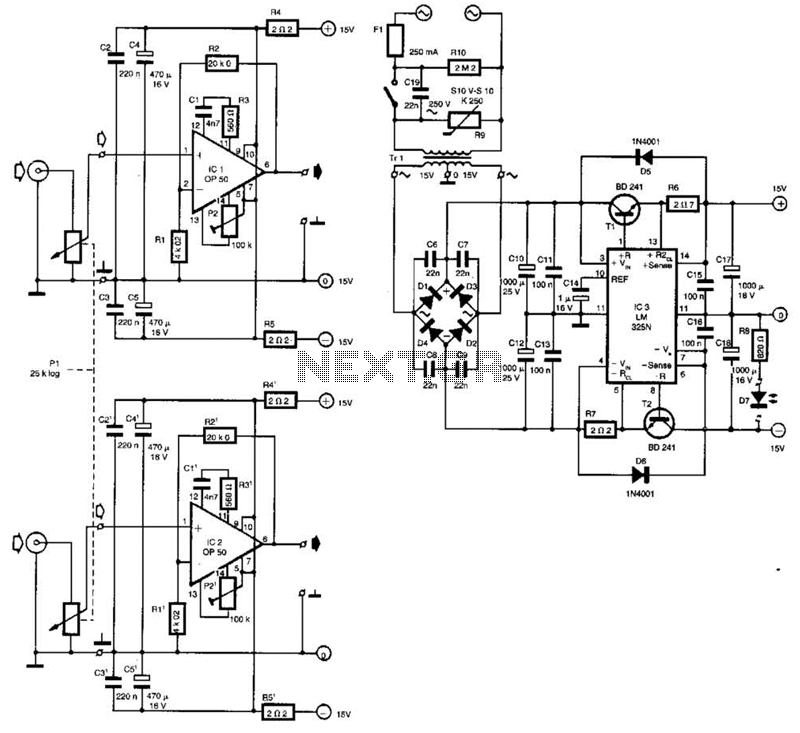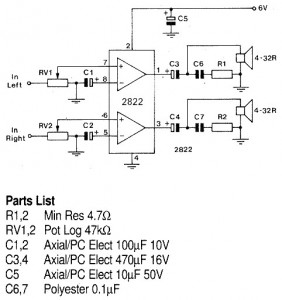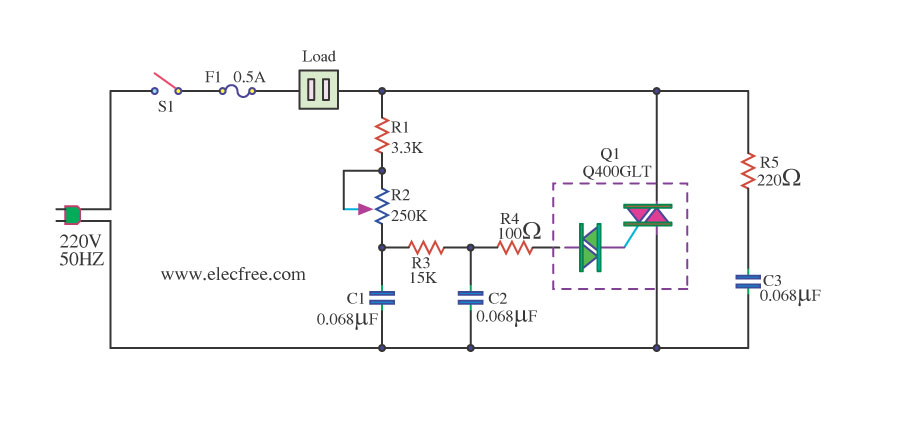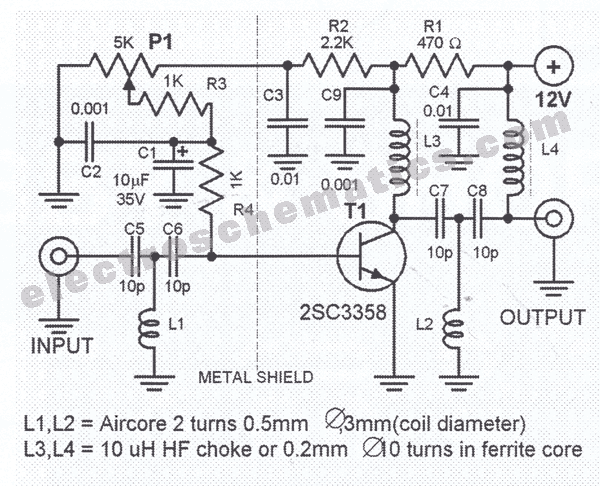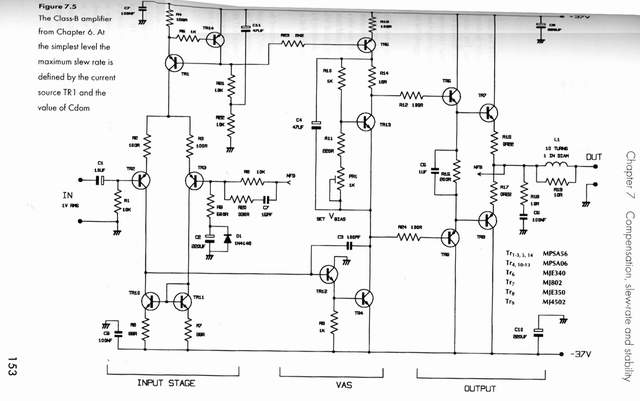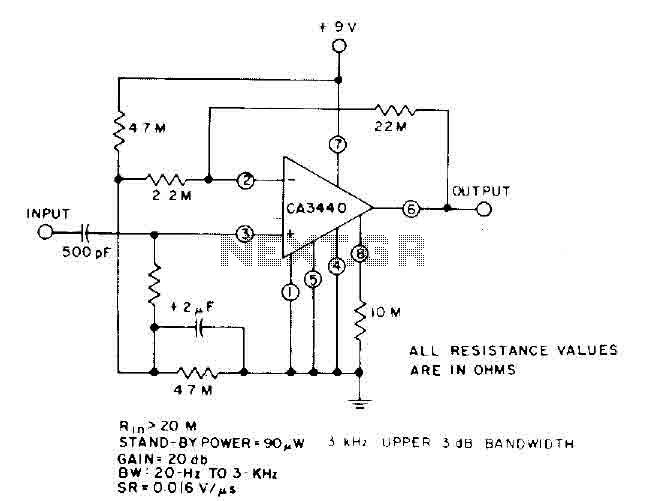
60 watt bass amplifier
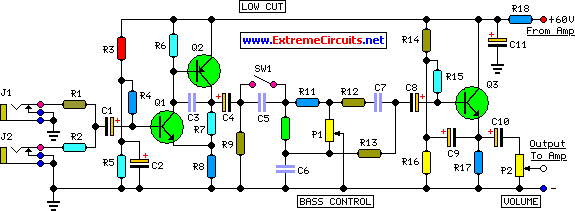
The advantages of a guitar amplifier include its straightforward circuitry, even with relatively high power outputs, and a built-in degree of loudspeaker protection provided by capacitor C8, which prevents voltage supply from reaching the loudspeakers in the event of output transistor failure. The preamplifier is powered by the same 60V rails as the power amplifier, enabling the implementation of a two-transistor gain block that can deliver approximately 20V RMS output. This configuration offers a high input overload capability. The listed Darlington transistor types may be oversized for this design; alternatives include MJ11014 (Q3) and MJ11013 (Q4) or TIP142 (Q3) and TIP147 (Q4). When using Darlington transistors as output devices, it is crucial for the sensing transistor (Q2) to maintain close thermal contact with the output transistors. A TO126-case transistor type is preferred for easy mounting on the heatsink, positioned very close to the output pair. Resistor R9 must be adjusted to measure about half the voltage supply across the positive lead of capacitor C7 and ground. A more precise setting can be achieved with an oscilloscope to ensure symmetrical clipping of the output waveform at maximum output power.
The guitar amplifier circuit is designed to provide high performance with a simplified approach. The straightforward circuitry is advantageous for both manufacturing and maintenance, making it accessible for both hobbyists and professionals. The built-in loudspeaker protection mechanism, facilitated by capacitor C8, is a critical feature that enhances the reliability of the amplifier by preventing potential damage to the loudspeakers during output transistor failures.
The preamplifier section, powered by the 60V rails, plays a vital role in amplifying the weak signals from the guitar. The two-transistor gain block is a common configuration that provides significant output voltage while maintaining high input overload capability, which is essential for handling dynamic guitar signals without distortion.
When selecting output transistors, the choice of MJ11014, MJ11013, TIP142, or TIP147 is significant. These transistors are capable of handling the power requirements without introducing excessive thermal stress. The thermal management of the output stage is critical; therefore, the placement of the sensing transistor (Q2) in close proximity to the output transistors ensures accurate thermal feedback for biasing, which is essential for maintaining performance and reliability.
The adjustment of resistor R9 is a key step in the calibration process. By setting R9 to achieve half the voltage supply across the positive lead of C7 and ground, the circuit can be optimized for performance. Utilizing an oscilloscope for this adjustment allows for precise monitoring of the output waveform, ensuring that the amplifier can achieve symmetrical clipping at maximum output power, which is crucial for maintaining audio fidelity during high-volume operation.
Overall, this guitar amplifier design exemplifies a balance between simplicity, performance, and reliability, making it suitable for various applications in music performance and recording.The advantages for a guitar amplifier are the very simple circuitry, even for comparatively high power outputs, and a certain built-in degree of loudspeaker protection, due to capacitor C8, preventing the voltage supply to be conveyed into loudspeakers in case of output transistors` failure. The preamp is powered by the same 60V rails as the power amplifier, allowing to implement a two-transistors gain-block capable of delivering about 20V RMS output. This provides a very high input overload capability. The Darlington transistor types listed could be too oversized for such a design. You can substitute them with MJ11014 (Q3) and MJ11013 (Q4) or TIP142 (Q3) and TIP147 (Q4). In all cases where Darlington transistors are used as the output devices it is essential that the sensing transistor (Q2) should be in as close thermal contact with the output transistors as possible.
Therefore a TO126-case transistor type was chosen for easy bolting on the heatsink, very close to the output pair. R9 must be trimmed in order to measure about half the voltage supply across the positive lead of C7 and ground.
A better setting can be done using an oscilloscope, in order to obtain a symmetrical clipping of the output wave form at maximum output power. 🔗 External reference
The guitar amplifier circuit is designed to provide high performance with a simplified approach. The straightforward circuitry is advantageous for both manufacturing and maintenance, making it accessible for both hobbyists and professionals. The built-in loudspeaker protection mechanism, facilitated by capacitor C8, is a critical feature that enhances the reliability of the amplifier by preventing potential damage to the loudspeakers during output transistor failures.
The preamplifier section, powered by the 60V rails, plays a vital role in amplifying the weak signals from the guitar. The two-transistor gain block is a common configuration that provides significant output voltage while maintaining high input overload capability, which is essential for handling dynamic guitar signals without distortion.
When selecting output transistors, the choice of MJ11014, MJ11013, TIP142, or TIP147 is significant. These transistors are capable of handling the power requirements without introducing excessive thermal stress. The thermal management of the output stage is critical; therefore, the placement of the sensing transistor (Q2) in close proximity to the output transistors ensures accurate thermal feedback for biasing, which is essential for maintaining performance and reliability.
The adjustment of resistor R9 is a key step in the calibration process. By setting R9 to achieve half the voltage supply across the positive lead of C7 and ground, the circuit can be optimized for performance. Utilizing an oscilloscope for this adjustment allows for precise monitoring of the output waveform, ensuring that the amplifier can achieve symmetrical clipping at maximum output power, which is crucial for maintaining audio fidelity during high-volume operation.
Overall, this guitar amplifier design exemplifies a balance between simplicity, performance, and reliability, making it suitable for various applications in music performance and recording.The advantages for a guitar amplifier are the very simple circuitry, even for comparatively high power outputs, and a certain built-in degree of loudspeaker protection, due to capacitor C8, preventing the voltage supply to be conveyed into loudspeakers in case of output transistors` failure. The preamp is powered by the same 60V rails as the power amplifier, allowing to implement a two-transistors gain-block capable of delivering about 20V RMS output. This provides a very high input overload capability. The Darlington transistor types listed could be too oversized for such a design. You can substitute them with MJ11014 (Q3) and MJ11013 (Q4) or TIP142 (Q3) and TIP147 (Q4). In all cases where Darlington transistors are used as the output devices it is essential that the sensing transistor (Q2) should be in as close thermal contact with the output transistors as possible.
Therefore a TO126-case transistor type was chosen for easy bolting on the heatsink, very close to the output pair. R9 must be trimmed in order to measure about half the voltage supply across the positive lead of C7 and ground.
A better setting can be done using an oscilloscope, in order to obtain a symmetrical clipping of the output wave form at maximum output power. 🔗 External reference
